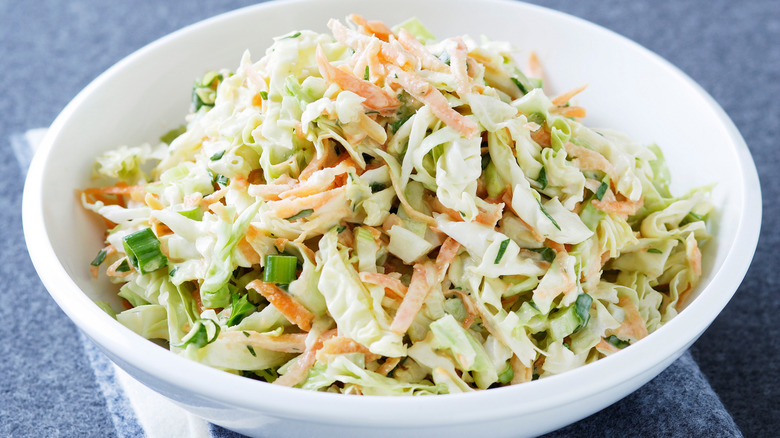Here's The Best Type Of Cabbage To Use For Coleslaw
As the days become longer and temperatures warmer, home cooks need to synchronize with the changing seasons. Let those meat-based stocks and stews hibernate in the freezer until next winter — it's time to break out the brighter, crisper, and lighter accompaniments to your protein fix. Coleslaw is arguably best suited to a summer meat dish, but with so many cabbage types, it can be tough to decide which to shred. Joanne Gallagher, recipe creator and co-founder of Inspired Taste, gave us her tips on the best types of cabbage for coleslaw.
Gallagher says green, red, savoy, or Napa cabbage all work well, but each has its own benefits and potential pitfalls. "Green cabbage is the most common, offering a crisp texture and mild flavor that pairs well with dressings," she tells The Takeout. "Red cabbage adds lovely color and a slightly peppery taste, making coleslaw look so vibrant." Savoy and Napa cabbage, on the other hand, yield a softer slaw, she shares. Due to their lighter texture and milder flavor, a savoy- or Napa-based coleslaw would be less punchy.
If forced to choose one, Gallagher says she reaches for green cabbage. "Green cabbage is very accessible, cheap, and has a sturdy texture that holds dressings well, making it a great choice for coleslaw," she explains. "Its mild sweetness pairs with creamy and vinegar-based dressings, making it versatile." Gallagher also suggests combining green and red cabbage together: Green cabbage adds sturdiness and crunch, while the red cabbage imparts both color and bite.
How to prep the cabbage for coleslaw
When making coleslaw, Gallagher says she first completely quarters a head of cabbage to remove the core with ease. Then, she shreds the cabbage into fine, bite-size pieces and tosses with a bit of salt, which is one of the reasons why restaurant slaw tastes better than homemade versions. "By salting the cabbage lightly and letting it sit for about 30 minutes, you draw out extra moisture, ensuring a crisper texture that doesn't become watery once you add your dressing," Gallagher explains.
Once the excess moisture is separated, she rinses the cabbage with cold water and dries it in a salad spinner. "Rinsing and spinning it dry removes excess salt while maintaining that classic crunch," Gallagher says. "These steps are crucial before adding other ingredients because they prevent the coleslaw from becoming too soggy, especially if it will sit for a while before serving." Once the cabbage is set, you have a blank canvas for other flavors you may wish to add to the mix. There are a number of surprising ingredients you can add to mix things up, and a bit of tangy tzatziki makes for a perfect coleslaw dressing.

